Welcome to Sarawak, the Land of the Hornbills! Sarawak is home to a vast array of avian life, with more than 690 species of birds recorded.
The rainforest and mangrove habitats of Sarawak are home to many species of birds such as the majestic Rhinoceros Hornbill, the colorful Fairy Pitta, and the beautiful Black-crowned Pitta.
Sarawak is also home to many migratory birds, such as the Grey-headed Fish Eagle, which can be seen in the wetlands of Sarawak during the northern winter. Birdwatching is a popular activity in Sarawak, and there are many dedicated bird-watching trails in the region.
Whether you’re a novice or an experienced birder, Sarawak is the perfect place to explore and appreciate the amazing diversity of the avian world.
1. Hornbill
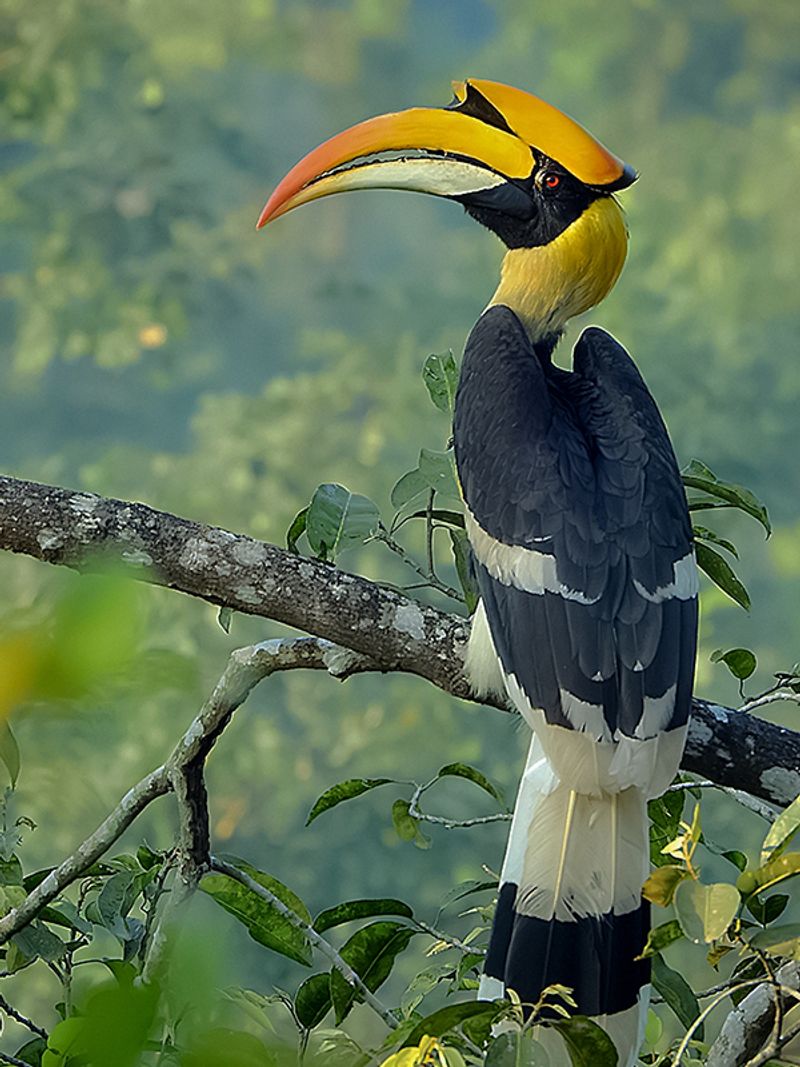
Hornbills are a family of large birds found in tropical and subtropical regions of Africa, Asia, and Melanesia. They are easily recognizable due to their distinctive long, down-curved bills which are often brightly colored.
In some species, the upper mandible of the bill is adorned with an additional structure called a casque. Hornbills are believed to be closely related to woodpeckers, and they share a wide variety of behaviors and physical characteristics with them.
They feed primarily on fruits, but also insects, small animals, and carrion. Hornbills are monogamous and they form lifelong pair bonds. The female typically builds a nest in a tree cavity, and then seals herself inside the nest with a mud wall while incubating the eggs.
The male then feeds her through the small opening in the wall. This nesting behavior is unique among birds. Hornbills are important in many cultures, and they are often found in art and mythology.
Some tribes believe that hornbills are messengers of the gods and can bring good luck. They are also important to many ecosystems, as they disperse seeds and help control insect populations.
| Kingdom | Animalia |
| Phylum | Chordata |
| Class | Aves |
| Order | Bucerotiformes |
| Family | Bucerotidae |
2. Rhinoceros Hornbill
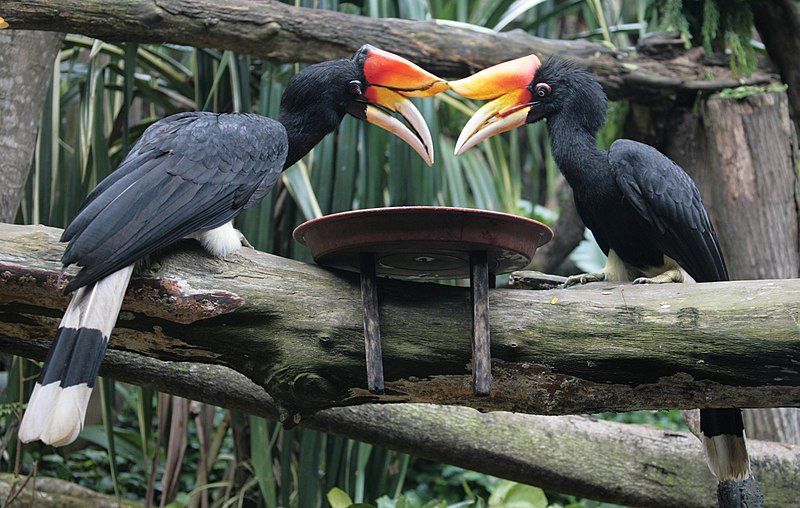
The Rhinoceros Hornbill is a unique species of hornbill found in many different climates and habitats. It is a large bird, with a long curved beak and a distinctive crest on its head.
In captivity, the Rhinoceros Hornbill can live up to 35 years, making it a long-lived species. This species is found in lowland and montane, tropical and subtropical climates, and in mountain rainforests, as high as 1,400 meters.
It is found in the regions of Borneo, Sumatra, Java, the Malay Peninsula, Singapore, and southern Thailand. The Rhinoceros Hornbill’s diet consists of fruits, insects, and small animals, including lizards, frogs, and birds.
It is a solitary bird, preferring to roam the forests alone.
However, the Rhinoceros Hornbill is also known to form large flocks when food is abundant, and this flocking behavior is seen especially during the breeding season. The Rhinoceros Hornbill is an important component of the tropical rainforest ecosystem.
It helps to disperse the seeds of the fruits it eats, which helps to promote the growth of new plants and trees. This species is also important to the local people, who use the feathers for traditional ceremonies, and it is also hunted for its meat.
Unfortunately, the Rhinoceros Hornbill is threatened due to habitat loss and illegal hunting. It is listed as vulnerable on the IUCN Red List of Threatened Species.
| Kingdom | Animalia |
| Phylum | Chordata |
| Class | Aves |
| Order | Bucerotiformes |
| Family | Bucerotidae |
| Genus | Buceros |
| Species | B. rhinoceros |
3. Black Oriole

Source: ebird.org
The black oriole is a species of bird in the family Oriolidae, which is native to the island of Borneo. It is one of the least known orioles, and its range is limited to the Sarawak region in Borneo.
The black oriole belongs to a group of birds known as the red and black oriole clade, which also includes the black-and-crimson, maroon, and silver orioles.
This group of birds is characterized by its bright colors, with the black-and-crimson oriole having vivid red and black plumage, the maroon oriole having deep purple and black feathers, and the silver oriole featuring silvery white and black plumage.
These birds are adept at foraging and catching insects in the trees of Borneo’s forests, and they are also quite social, often congregating in large flocks. The black oriole is an important species in the island’s ecosystem, as it helps to keep insect populations in check.
| Kingdom | Animalia |
| Phylum | Chordata |
| Class | Aves |
| Order | Passeriformes |
| Family | Oriolidae |
| Genus | Oriolus |
| Species | O. hosii |
4. White-crowned Hornbill
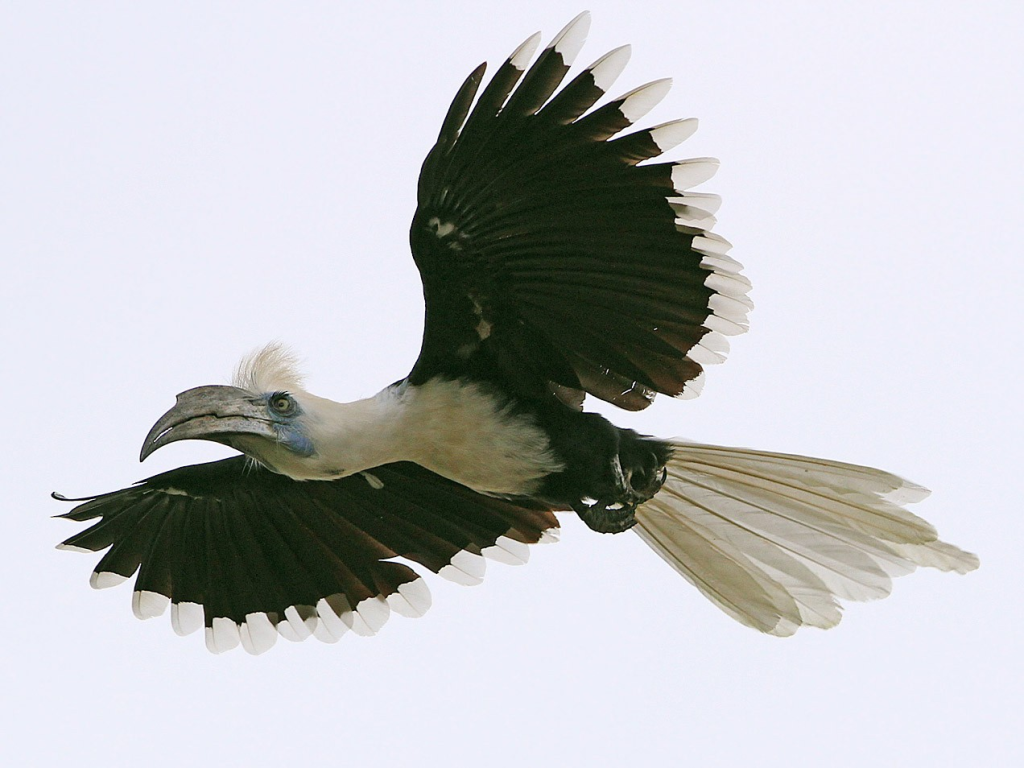
Source: ebird.org
The white-crowned hornbill is a species of hornbill known for its distinctive white crest. It is native to tropical Southeast Asia, where it is found in countries such as Indonesia, Malaysia, and Thailand.
The bird is also known by several other names, including the long-crested hornbill and white-crested hornbill.
These names are all derived from the species’ distinct physical characteristics. The white-crowned hornbill is a medium-sized bird with a body length of about 60 cm, and a wingspan of around 80 cm. Its wings are black in color, while its body is predominantly dark grey and black.
The most distinguishing feature of this species is its white crest, which is made up of long feathers that extend down its back.
The feathers of the white-crowned hornbill’s crest are often banded with black and white stripes. The white-crowned hornbill is a solitary bird that is often found in the lowland forests of its native range.
It is an omnivorous species, and its diet consists of a variety of fruits, insects, and small reptiles.
The white-crowned hornbill is also known to occasionally take fish from streams. The white-crowned hornbill is considered to be a vulnerable species, as its population is declining due to deforestation and hunting.
As such, the conservation of this species is important, and efforts are being made to protect its habitat and numbers.
| Kingdom | Animalia |
| Phylum | Chordata |
| Class | Aves |
| Order | Bucerotiformes |
| Family | Bucerotidae |
| Genus | Berenicornis |
| Species | B. comatus |
5. Oriental Pied Hornbill
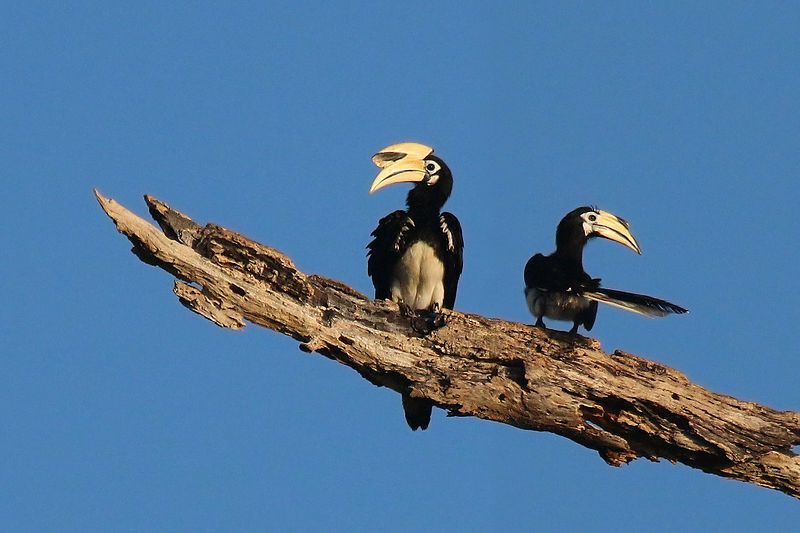
The oriental pied hornbill is a species of hornbill that can be found in the Indo-Malayan region. It is a large bird that lives in the canopy of the forest. It has two other names: the Sunda pied hornbill and the Malaysian pied hornbill.
This species is considered to be one of the smallest and most widely distributed of the Asian hornbills. It is a highly social bird, often seen in large groups. The oriental pied hornbill generally has a black and white plumage, with a white head and neck.
The bill of this species is large and yellow with a black tip. The wings and tail are usually black, while the legs and feet are orange.
The adult male has a red patch on its throat, whereas the adult female does not. The oriental pied hornbill is an omnivore and mainly feeds on fruits, insects, small mammals, and reptiles. It is usually seen foraging in the canopy of the forest.
The birds live in pairs or small family groups and are known to be quite vocal. They use a range of calls to communicate with each other, including loud honks, whistles, and screeches. The oriental pied hornbill is an important species for the local ecosystems.
They are important seed dispersers, helping to spread the seeds of the plants they eat. They also help to control insect populations, which can benefit the local vegetation. Unfortunately, their numbers are declining in many areas due to habitat destruction and hunting.
Conservation efforts are necessary to ensure their survival.
| Kingdom | Animalia |
| Phylum | Chordata |
| Class | Aves |
| Order | Bucerotiformes |
| Family | Bucerotidae |
| Genus | Anthracoceros |
| Species | A. albirostris |
6. Bulwer’s Pheasant
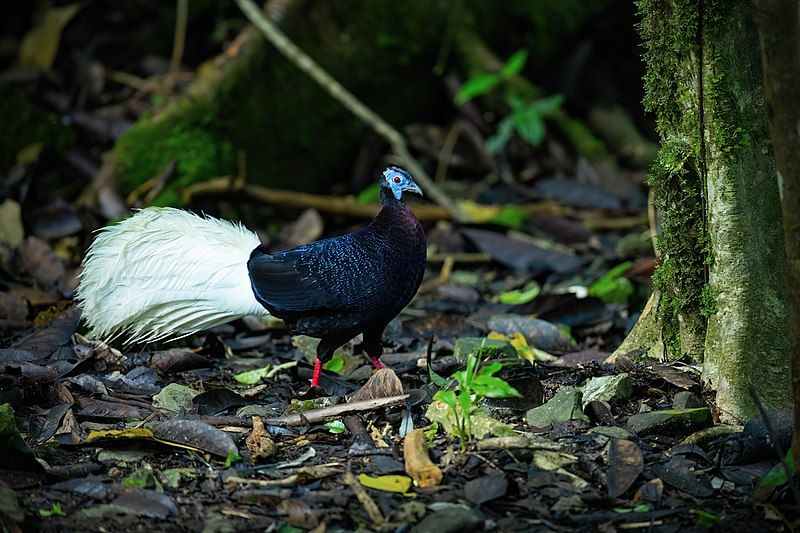
Bulwer’s pheasant is an endangered species of bird native to the forests of Borneo. It is a member of the family Phasianidae and is also known as Bulwer’s wattled pheasant, the wattled pheasant, or the white-tailed wattled pheasant.
This species is currently listed as Vulnerable by the International Union for Conservation of Nature (IUCN). This bird is primarily found in the tropical and subtropical forests of Borneo and is characterized by its unique wattles on its neck and head.
The wattles are usually reddish in color, and the male of the species has a distinctive white tail.
The feathers of this species are mainly black and brown, with some white markings on its wings and tail. Bulwer’s pheasant is a species that is threatened by habitat destruction due to deforestation and logging activities.
The IUCN has listed this species as Vulnerable, which means that it is facing a high risk of becoming endangered in the near future.
To help protect this species, conservation efforts have been put in place to preserve the habitats of the species and to reduce the impact of human activities on the species’ populations. Overall, Bulwer’s pheasant is a beautiful species with unique wattles and coloration.
Unfortunately, it is facing a high risk of extinction due to habitat destruction. Conservation efforts are needed in order to protect this species and ensure its survival in the future.
| Kingdom | Animalia |
| Phylum | Chordata |
| Class | Aves |
| Order | Galliformes |
| Family | Phasianidae |
| Genus | Lophura |
| Species | L. bulweri |
7. Black Hornbill
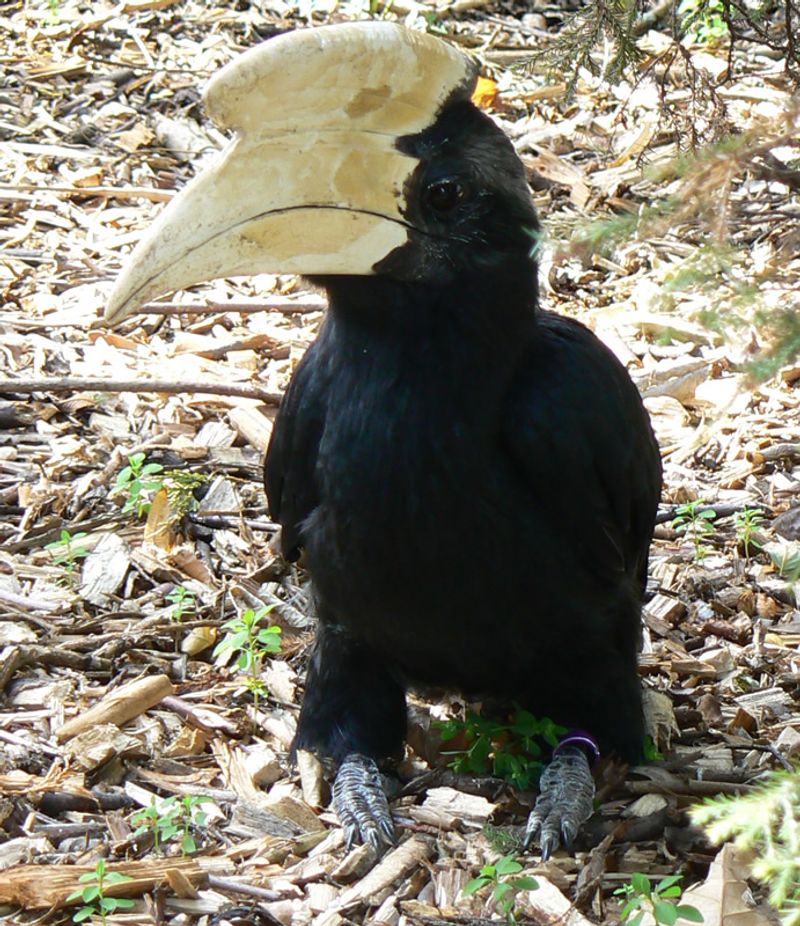
The Black Hornbill is an important species of bird found in parts of Asia, including Brunei Darussalam, Indonesia, Malaysia, Singapore, and Thailand. It belongs to the Hornbill family Bucerotidae and is known for its distinctive black casque or helmet-like crest.
When it comes to reproduction, the Black-casqued Hornbill is quite selective when it comes to its environment and resources.
This species prefers to inhabit areas with a high amount of food resources, and it has been observed that they tend to avoid areas of disturbed habitat such as those affected by human activity.
They have also been seen to choose habitats that offer protection from predators, such as tall trees or dense forests.
The Black Hornbill is known to use its casque to help it locate food sources, and it has been observed that they tend to form pairs when looking for food, with the male being the primary provider.
This species is very important to the local environment, as it helps to maintain the balance of the ecosystem by consuming a wide variety of fruits and other food sources.
| Kingdom | Animalia |
| Phylum | Chordata |
| Class | Aves |
| Order | Bucerotiformes |
| Family | Bucerotidae |
| Genus | Anthracoceros |
| Species | A. malayanus |
8. Bushy-crested Hornbill
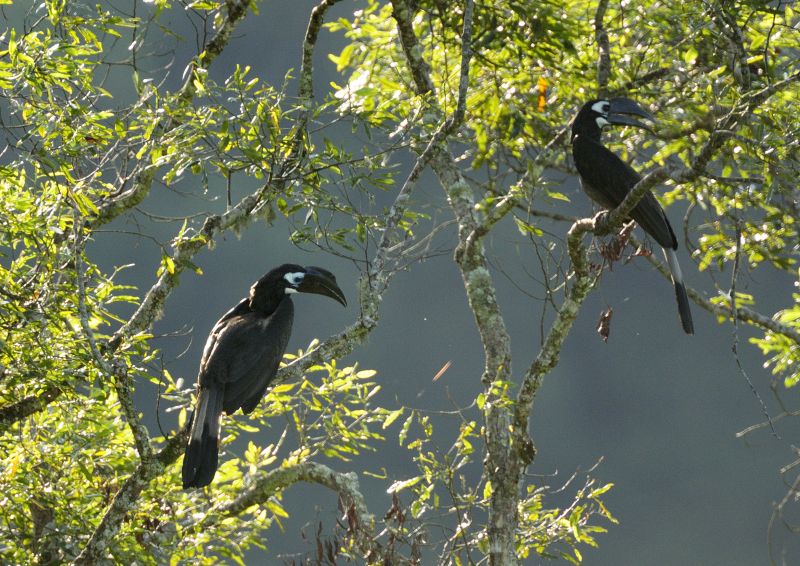
The bushy-crested hornbill is a species of bird that is found in the hornbill family. This species of bird can be located in five different countries in Southeast Asia: Brunei, Indonesia, Malaysia, Myanmar, and Thailand.
In addition to its presence in the region, it is also native to subtropical and tropical moist lowland forests. These forests provide an ideal environment for the bird to thrive, as they feature lush vegetation and plenty of food sources.
Additionally, these forests are often filled with a variety of other animals and insects, which give the bushy-crested hornbill an abundant source of prey. The bird relies heavily on its beak and claws to catch prey, making it an efficient and successful hunter.
Its distinct bushy crest also provides it with camouflage, allowing it to blend in with its surroundings.
| Kingdom | Animalia |
| Phylum | Chordata |
| Class | Aves |
| Order | Bucerotiformes |
| Family | Bucerotidae |
| Genus | Anorrhinus |
| Species | A. galeritus |
9. Wrinkled Hornbill
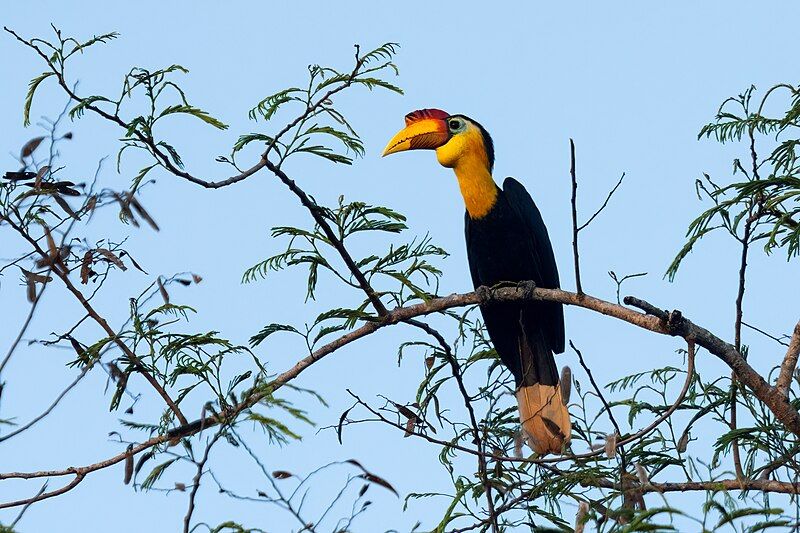
The wrinkled hornbill, also known as the Sunda wrinkled hornbill, is a species of medium-sized bird found in the forests of the Thai-Malay Peninsula, Sumatra, and Borneo.
It is approximately 70 centimeters in length and has a distinctive feature in its striking, large, fused bill.
This species of hornbill is characterized by its wrinkled forehead, hence its name. The wrinkled hornbill is a carnivorous bird, feeding on insects, small reptiles, and other small animals.
It is an arboreal species, meaning it lives in trees, sometimes using hollowed-out tree trunks as nests.
It has a unique nesting behavior, in which the female seals herself and her eggs into a tree cavity, relying on the male to feed her. In terms of conservation, the wrinkled hornbill is classified as near-threatened due to habitat loss and degradation caused by logging and deforestation.
Their populations are also declining due to illegal hunting. It is important that we do what we can to protect and conserve this species and its habitat if we want to ensure its survival.
| Kingdom | Animalia |
| Phylum | Chordata |
| Class | Aves |
| Order | Bucerotiformes |
| Family | Bucerotidae |
| Genus | Rhabdotorrhinus |
| Species | R. corrugatus |
10. Wreathed Hornbill
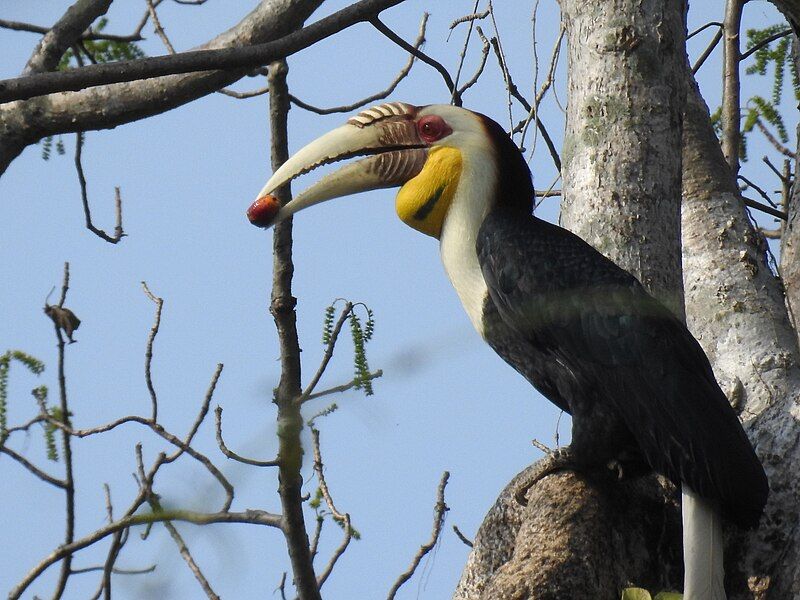
The wreathed hornbill is a type of bird found in tropical regions of the world, belonging to the family of birds known as Bucerotidae. Its most notable feature is a bright blue-black band on its lower throat sac which gives it the nickname of bar-pouched wreathed hornbill.
This species of hornbill is known for its large beak and its relatively large size, making it a very distinct bird. The wreathed hornbill is found in many countries in the Old World, including India, Bangladesh, Thailand, and Indonesia.
It is a solitary bird, preferring to live alone in the forest canopy and feed on fruits and large insects.
It is also known to use its beak to dig nesting holes in the trees for its young. The wreathed hornbill is an important species for conservationists as it plays an important role in its ecosystem.
It helps disperse seeds from the fruits it eats, and its large beak can help clear out dead wood, providing important nutrients for other animals in the forest.
It is also a valuable source of food for other animals such as the great hornbill. Unfortunately, the wreathed hornbill is under threat due to habitat loss and illegal hunting.
It is listed as vulnerable by the IUCN Red List of Threatened Species, and conservation efforts are being made to protect this species and its habitat. With continued protection and habitat restoration, the wreathed hornbill may have a chance at survival.
| Kingdom | Animalia |
| Phylum | Chordata |
| Class | Aves |
| Order | Bucerotiformes |
| Family | Bucerotidae |
| Genus | Rhyticeros |
| Species | R. undulatus |
Conclusion
Birds in Sarawak are incredibly diverse and unique. They range from small, colorful species found in urban areas to larger, more powerful species found in the rainforest. The number of species found in Sarawak is truly impressive, and many of them are endangered.
With the right protection and conservation measures, these birds can continue to thrive and remain a part of the unique and beautiful biodiversity of Sarawak.